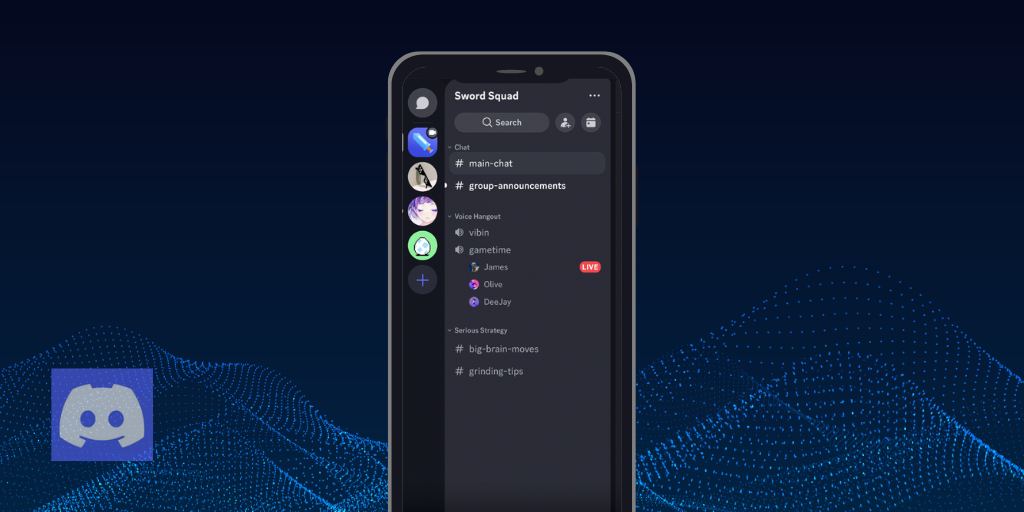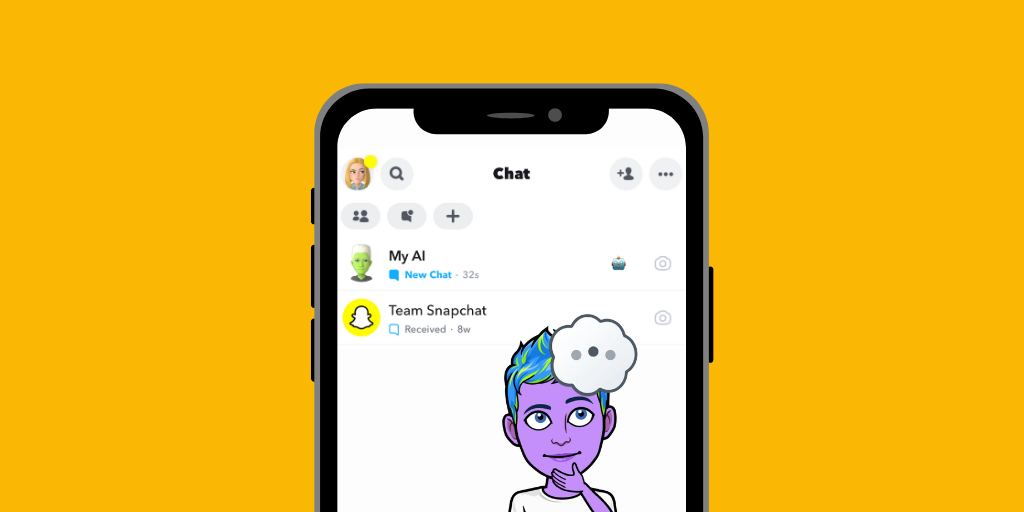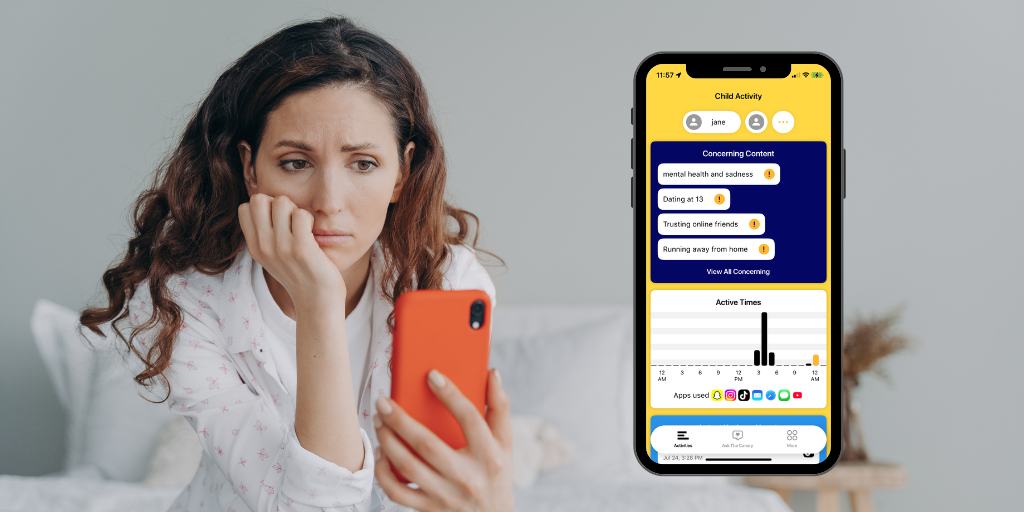
Discord is one of the most popular platforms for teens to hang out online. While it’s generally safe for users over 13, there’s always the possibility of cyberbullying or unwanted contact.
This guide explains how to block someone on Discord step by step, what happens when you block a user, and additional safety steps for parents.
Blocking someone on Discord is simple. Here’s how to do it on both desktop and mobile devices:
You can also block a user by right-clicking their name in the Friends List or within a DM, then selecting Block.
Did you know? You can monitor your child’s Discord activity with BrightCanary. You’ll also get alerts for concerning content, like bullying and harmful messages.
Your child might worry about the social fallout when they block someone, but blocking is a helpful way to prevent someone from continuing to harass your child. Here’s how to explain what happens when your child blocks someone:
In addition to helping them block the user who’s bullying them, here are some other steps you can take to keep your child safe:
Discord strictly prohibits bullying on its platform, and such action could potentially lead to a suspension. Here’s how to report it:
If the behavior continues, having these details will be helpful.
Don’t minimize the situation or make excuses for the aggressor. It’s important that your words and actions convey unconditional support and a desire to stop the bullying.
If the bullying is based on gender, race, or disability, contact the Office of Civil Rights.
If the bullying involves physical threats, contact law enforcement. If your local police department isn’t helpful, contact county or state officials, as they often have more expertise and resources for dealing with technology-related crimes.
Do you have additional questions about how blocking works on Discord? We’ve got answers!
No. A blocked user cannot DM you. In shared servers, their messages appear as “Blocked Message,” but you can click to reveal them.
Signs include being unable to DM them, invite them to servers, or react to their messages. They’ll disappear from your Friends list, and their status will always show as “Invisible.”
Yes. Go to your Blocked Users list or find them in a shared server, then select Unblock.
If the blocked user was previously on your Friend list, they’ll be automatically unfriended when you block them.
Yes. If you block someone on Discord, all DMs from before you blocked them will still be visible.
Discord is generally safe for teens, but bullying and harassment are real risks. If this happens, help your child block the person bullying them and report the issue to Discord. It’s also important to support your child emotionally by making it clear the situation is not their fault.
BrightCanary can help you monitor your child online, including on Discord. Our advanced technology scans what they type and alerts you if they encounter anything harmful, such as cyberbullying, so you can step in and support them. Download BrightCanary today to get started.

Is it just me, or does it feel like every time you turn around, there’s another new instance of AI? Snapchat has jumped on the bandwagon with its My AI feature, a chatbot embedded in users’ DMs. This begs the question: Is My AI on Snapchat safe for kids?
Snapchat’s My AI chatbot may seem fun and harmless, but it’s not safe for kids. While it can provide homework help or movie suggestions, the risks — including inappropriate responses, dependency, and privacy concerns — make My AI a poor choice for children.
This article will go over what My AI is, how your child might use it, the risks, and how to talk to your child about it.
My AI is Snapchat’s AI chatbot. It’s powered by large language models from Open AI, Gemini, and Google, and customized for Snapchat.
The chatbot can be found in Snapchat’s chat feature. It talks in a conversational format, responding to users’ questions and prompts.
Kids use Snapchat’s My AI in many of the same ways they do other AI companions. Specifically:
Snapchat has specific safety enhancements and controls for My AI. For example, if your child talks about things like self-harm, My AI will recommend safety resources, and it will block results for questions and prompts related to drugs. Snapchat also recently expanded parental controls for AI.
Despite these measures, My AI still poses notable risks for kids:
Nonprofit media watchdog Common Sense Media deemed AI companions unsafe for users under the age of 18. Additionally, numerous lawsuits have been filed alleging serious safety issues for children using chatbot companions.
While Snapchat has taken more measures than some companies, the risk simply isn’t worth it: Snapchat’s My AI isn’t safe for kids.
Here’s what you can do to limit your child’s risk:
If you decide to let your child use My AI, it’s important to guide them to use it more safely.
First, discuss the risks. Explain that AI conversations aren’t always accurate, and they aren’t a replacement for talking to a real person. Your child should know not to take advice from an AI.
Empower your child to:
My AI is Snapchat’s built-in chatbot that uses artificial intelligence to respond to users’ questions and prompts inside the app’s chat feature. It can suggest movies, answer trivia, or help with homework, but it’s also designed to collect data for targeted ads and language learning.
Kids often turn to My AI for entertainment, companionship, or quick answers. They might use it to:
Despite safety updates, My AI poses risks for children, including unsafe or misleading advice and targeted ads based on the content of their chats.
No. Experts, including Common Sense Media, recommend against AI chatbots for users under 18. The potential for unsafe responses, loss of privacy, and dependency outweighs any benefits.
Parents can reduce risks in two ways:
There are many reasons kids are drawn to Snapchat’s My AI feature. But the risks don’t outweigh the benefits. Snapchat’s My AI feature isn’t a safe choice for kids and should be disabled using parental controls. If parents choose to let their kids use it, other measures should be taken to protect their safety.
BrightCanary helps parents monitor their children on the apps they use the most, including conversations with Snapchat’s My AI. Download today to get started for free.

If you’re concerned about the safety of TikTok for your child and looking for alternatives, you might come across Triller in your search. But though the app frequently lands itself on lists of kid-safe alternatives to TikTok, it’s not without risk.
So, is Triller safe for kids? In this article, we’ll take a look at the dangers of Triller, how it compares to TikTok, and why it’s not the safest choice for kids.
No, the Triller app is not safe for kids. Unlike TikTok, Triller has no parental controls, no age verification, and allows direct messages from strangers. The app also contains large amounts of inappropriate content, making it unsafe for children and younger teens.
Triller is a short-form video platform similar to TikTok and Instagram Reels. It allows users to create and post videos and view other users’ content.
Originally intended as a music video app, the platform has a broader range of music to choose from and a more overt focus on fame and gaining followers than other platforms.
Triller lets users film multiple takes of a video and then use the built-in AI editing tools to automatically select and combine the best clips to generate a slick-looking video.
Like other social media platforms, Triller users can follow other creators and like and comment on videos. And similar to TikTok, Triller suggests videos for users, but unlike TikTok, which suggests videos based on a user’s watch history, Triller’s Discover page is based around promoted campaigns, top videos, and genre categories.
Not only does Triller have no parental controls, but it also lacks any form of age verification.
Although Triller has a few (read, very few) safeguards in place, like the ability to set accounts to private, turn off data collection, and block users, the red-flags are plentiful.
All things considered, Triller is much less safe than TikTok. Here’s how the apps stack up:
Feature | TikTok | Triller |
| Parental controls | Yes | No |
| Age verification | Yes, easy to bypass | No |
| Limit direct messages | Yes | No, must block users individually |
| Content moderation | Yes, but explicit content slips through | Yes, but explicit content slips through |
| Explicit material | Prohibited but common | Prohibited but common |
| Community Guidelines | Yes, but not kid-focused | Yes, but not kid-focused |
Triller is a video-sharing app that has its sights set on competing with TikTok. But Triller is not safe for kids, including younger teens. With inappropriate content, a lack of parental controls and age verification, and no ability to limit who can message you, Triller is only appropriate for users 17 and older.
BrightCanary helps parents monitor what their children type and search on the apps they use the most, including Triller and TikTok. Download today to get started for free.

Adolescence is a time of major social and emotional change. As anyone who’s witnessed a preteen door slam can attest, it can bring with it some pretty big feelings. It’s also notoriously when kids start to withdraw from parents and often refuse to talk about what’s really bothering them.
If you want to check in with your child’s emotional well-being but are hitting a brick wall, BrightCanary is an excellent tool for improving your connection with your closed-off kiddo.
This article will explain how BrightCanary’s advanced emotional insights, coupled with some tried-and-true analog parenting strategies, can help you understand what’s going on with your child so you can spot any red flags and do your part to support their well-being.
Child emotional well-being refers to how kids manage their feelings, cope with stress, and build healthy relationships. It’s a key part of mental health, especially during adolescence when emotions can feel overwhelming.
It’s normal for your adolescent to have a hard time talking about their feelings with you, but they still need your support. That’s why it’s imperative to stay in tune with them. Here are some strategies that combine technology and face-to-face interactions to give you insight into your child’s emotional state:
Showing interest in what your child likes demonstrates that what they value is important to you. That connection may motivate them to open up more. Because so much of modern adolescence takes place online, many of their interests may be hidden behind a device. That’s where BrightCanary comes in.
The Interests section of the BrightCanary app shows you what’s captivating your child’s attention, so you know if they’re obsessed with KPop Demon Hunters or have a concerning fixation with skincare.
Focus on creating screen-free time and space for connection. Some good times to have them put down the phone:
From exchanging memes to learning how to text with teens to using the BrightCanary Keyboard, coupling digital solutions with offline strategies is an effective way to stay in tune with your child’s well-being.
Sure, it’d be great if your child let you in on what they’re feeling and came to you every time something was wrong. But we all know that’s not going to happen.
BrightCanary’s robust emotional insights use AI technology — informed by the American Psychological Association’s (APA) emotional categories — to bridge the gap and help you understand what your child is going through.
If you notice any of these signs, set aside some time to check in with your child. Remind them that they can talk to you about anything, even if they don’t fully understand what they’re feeling.

BrightCanary’s emotional insights were developed utilizing the widely recognized categories of emotions. Here’s how it works:
Technology is a great tool, but it’s not the endgame when it comes to your child’s well-being. Here’s how to couple BrightCanary’s AI-powered insights with your uniquely human parenting skills to level up how you support your child.
Knowing your child’s emotions is key to understanding their well-being, yet tweens and teens often have a hard time opening up about how they’re feeling. BrightCanary’s research-backed emotional insights help you understand the stress, social pressure, and emotional ups and downs your child is going through. Download the app today so you can better support your child’s well-being.

Private browsers like DuckDuckGo and Brave are increasing in popularity. But what are privacy browsers, and how are they different from incognito mode? And how can you keep your child safe online when they use a private browser?
This article explains how private browsers work, the risks they pose to kids, and how BrightCanary helps you monitor your child regardless of what browser they use.
A private browser is a third-party browser that blocks tracking, encrypts data, and enhances user anonymity online. Unlike mainstream browsers like Chrome and Firefox, these browsers must be manually downloaded onto a device and often include additional privacy features.
Some popular privacy browsers include:
Here’s how private browsers stack up against incognito mode:
| Feature | Incognito/private mode on most mainstream browsers | Private browsers |
| Tracks cookies and data | Yes | No |
| Saves search history | No | No |
| Encrypts traffic | No | Yes |
| Hides IP address | No | Some, like Tor |
Although the terms are often used interchangeably, private browsers are different from incognito mode (also known as private browsing) on mainstream browsers.
The biggest distinction is that private browsers don’t allow any tracking of your child’s online activity, whereas incognito mode is more limited in the privacy it provides.
Basically, both modes limit how much you can monitor your child’s online activity, but only private browsers restrict outside entities from tracking them.
The reasons why kids use private browsers range from unconcerning to worrisome.
If you or your child are concerned about their privacy online, it’s easy to see the benefits of them using a private browser. It’s also important to know the risks. Privacy browsers can:
These tools limit visibility. For parents of tweens and teens, that can be a concern.
If you’re concerned about your child using a private browser, you have two options:
You can restrict your child’s access to private browsers by blocking each one on their device or network. But there are many private browsers, and it’s hard to keep up with them all.
BrightCanary is a third-party app that helps you monitor your child’s online activity, even on private browsers. The difference is that BrightCanary monitors what your child types, including their activity on private browsers on their iPhone or iPad. If they’re searching for anything concerning, you’ll get an alert in real time.
Given the privacy benefits of using browsers like DuckDuckGo or Brave, you may want your child to use a private browser instead of a mainstream option like Chrome or Safari.
Here’s how BrightCanary can mitigate the risks and help you keep your child safe while using a private browser:
Private browsers like DuckDuckGo and Tor protect your child against tracking and ad targeting by companies and websites. The downside is that these browsers also make it difficult for you to monitor your child online.
Thanks to BrightCanary’s secure keyboard technology, you can still monitor your child’s online activity, even on private browsers. If they search for concerning content, you’ll get an alert and can access additional details in the app. Download BrightCanary today and get started.

If your tween or teen is an avid texter (and let’s face it, most are), there’s more to worry about than the likelihood they’ll develop texting thumb. Cyberbullying, predators, and sexting are just a few of the risks young people face from texting.
Monitoring their messages is a great way to mitigate these risks and keep an eye on your child’s emotional state. This article will go over how to view text messages sent and received by your child, including BrightCanary, which offers the most comprehensive text message monitoring for iPhones.
To view text messages sent and received by your child, you can manually check their phone, use another device to log into their iCloud, or use a parental monitoring app like BrightCanary. BrightCanary offers the most comprehensive solution with real-time alerts, summaries, and emotional insights across all messaging apps.
Let’s break it down:
| Method | Pros | Cons |
| Manual check | No setup required | Time-consuming, easy to bypass, no alerts |
| Log into their iCloud | Real-time access | No alerts, potential trust issues, requires certain settings |
| BrightCanary | Full text visibility, AI alerts, summaries | Subscription required |
If you’re looking for the most basic way to view your child’s texts, you can’t get any more straightforward than asking them to hand over their device so you can go through their messages.
As long as “Messages in iCloud” is enabled, you can sign into your child’s iCloud account on your own device to access their messages.
For parents who want to work smarter, BrightCanary offers the best parental monitoring for iPhones. The app uses AI technology to scan everything your child types (including text messages), flags issues of concern, and provides summaries along with emotional insights.
BrightCanary offers the most comprehensive text message monitoring for Apple devices. Here’s how:
Both plans offer insight into everything your child types. But for parents who want to go deeper, the Text Message Plus plan provides two-way message monitoring. That means, along with all the features listed above, you also get:
To use Text Message Plus, you’ll need your child’s Apple ID during setup.
Text messages are a primary form of communication for many tweens and teens. But texting exposes kids to risks like cyberbullying, predators, and sexting. Manually scanning their messages and device mirroring offer some protection. But for the best way to view text messages sent and received by your child, BrightCanary is the gold standard.
BrightCanary uses AI technology to scan everything your child types and alerts you to any concerning content. The app also offers summaries, emotional insights, and tailored parenting advice. It’s one tool, built for parents who care, with the ability to select the plan that meets your family’s needs. Download and get started today.

If your child struggles with focus, the new school year is likely to bring fresh worries. It’s important to be proactive, but you may be unsure about teaching them how to stay focused in school or struggle with the best way to talk to their school about the problem. To help empower you to support your kiddo’s educational journey, here are some tips on how to help your distracted child in the classroom.
Whether it’s behavior you notice at home or reports from your child’s school, here are some signs they may be struggling to focus in school:
Pro tip: If your child is using their phone while they’re supposed to be studying, you’ll be able to see their activity times in BrightCanary — as well as what they’re typing across all the apps they use.
Collaboration with your child’s school is key when it comes to helping them with attention issues. But it can be difficult to know how and when to reach out. Here are some tips:
According to Dr. Genét Simone, a Career and Technical Education teacher with Seattle Public Schools and author of Teaching in the Dark, if you suspect your child is struggling with attention in class, it’s best not to leave it up to the teacher to reach out.
They have many other students and very little time to contact parents, which means you may not hear about an issue until it reaches a boiling point.
It’s easy to want to defer to teachers because they’re the experts on classroom strategies. But remember, you’re the expert on your own child. When you reach out to the school, Simone encourages parents to include the following:
If you’ve found something that helps keep your child focused at home, share it with their teacher. It’s important not to be demanding, though. Be clear you realize this may not work for their classroom and instead offer it as an insight into your child that could help the teacher work with them better.
Simone suggests working with the teacher to brainstorm the best course of action. Different kids may need different support, and combining perspectives can help you come up with effective solutions.
What you do at home is a key component in your child’s success in the classroom. These strategies can help you support your child in staying more focused at school.
Attention issues can negatively impact a child’s school experience. If your kiddo struggles with staying focused in school, it’s important to be proactive and collaborate with both your child and their school to address the issue. Contacting their teacher with your concerns, trying strategies at home, and seeking professional help if the problem worsens or persists are all ways to help a distracted child in the classroom.
If your child spends a lot of time distracted by their phone, here's one easy way to stay informed and involved: BrightCanary. The app monitors what your child types across every app on iPhones and iPads, so you’ll get a sense of their interests, stressors, and emotional well-being. And if there are any red flags, you’ll get alerts in real time. Download BrightCanary and start your free trial.

As you start using the BrightCanary Keyboard to monitor your child’s safety online, some questions might arise: the insights are great, but what about my child’s privacy? How should I talk to my child about it? We hear you, and we have answers.
This guide will go over how the BrightCanary Keyboard can actually give your child more privacy, what to do if they don’t like the idea, and tips for talking to your child about it.
Experts advise that parents take a multi-pronged approach to keeping their child safe online, including monitoring and having ongoing discussions.
There are billions of strangers on the other side of your child’s device. Even the most mature and level-headed child is vulnerable to risks like cyberbullying, online scams, grooming, and access to inappropriate content that can easily cross their social feeds.
Monitoring is an extension of the supervision you already have in your child’s life. You wouldn’t let them wander a crowded city on their own or give them the keys to a car without any training. Similarly, kids shouldn’t go online without any restrictions — they need guardrails to help them learn how to use the internet and connected devices safely and responsibly.

The BrightCanary Keyboard provides more powerful protection online compared to other monitoring apps. Along with increased safety, it also supports your child’s privacy. Here’s how:
Adolescents are hardwired to seek independence, so it’s natural that they might have reservations about your monitoring efforts. At the same time (even though they’d never admit it) teens and tweens still need a lot of parental support.
Here are some tips for honoring their feelings and need for independence while providing them the guidance and safeguards they need.
Educate your child about the risks they face online in an age-appropriate way. Explain that it’s your job to help them stay safe and to teach them how to be responsible.
Installing a monitoring app without telling your child is spying, and your child would have every right to be upset. That’s why it’s important to sit down with your child before you start using the BrightCanary Keyboard.
Explain how you plan to use it, what you’ll be looking for, and what steps you’ll take if there’s a concern.
Ask your child about their online experience so far and what problems they’ve faced. Seek their input as you devise a plan for using the keyboard, and regularly check in to discuss how it’s going for them.
Some kids need more support and monitoring than others. In addition, tweens getting their first device or young teens starting out on social media need more parental involvement than older, more mature teens.
You know your child best; the BrightCanary Keyboard gives you the freedom to tailor the experience to fit your family.
Over time, it’s reasonable to make changes to your approach. As your child proves trustworthy, you might rely more on summaries and less on transcripts. If your child requests more space, try staying out of the smaller matters (such as foul language or your child’s latest crush).
Save your involvement for the things that really matter, like safety issues. Just as you adjusted their training wheels to provide less support as they became more competent bike riders, your involvement online should lessen as they mature, so they may eventually learn to ride on their own two wheels.
Finding the right words can be tricky. Here are some conversation starters:
The BrightCanary Keyboard provides more robust protection online compared to other monitoring apps. Along with increased safety, it also supports your child’s privacy with AI monitoring, robust summaries, and a design built for collaboration. Download today and start your free trial.

When my 10-year-old’s friends started raving about KPop Demon Hunters, I knew we had to check it out. Even though there are no K-pop fans in my house, the trailer was fun and I was probably more eager than my son to watch it.
Friends, it did not disappoint. If you’re contemplating watching this movie with your family, you’re probably wondering, like I did, if KPop Demon Hunters is appropriate for kids. Here’s what I found.
K-pop is a genre of South Korean popular music that blends various musical styles into ultra catchy tunes.
K-pop shows are characterized by strong visual elements and robust choreography that’s heavily influenced by hip-hop. K-pop has exploded beyond the music to become a global cultural fandom.
The premise of KPop Demon Hunters is centered around K-pop music and its subculture. KPop Demon Hunters does a good job of capturing the allure — if your kiddo isn’t into K-pop, they might well be after watching this movie.
The MPA rating for KPop Demon Hunters is PG for “action/violence, scary images, thematic elements, some suggestive material and brief language.”
But a PG rating can mean many things. So what age is KPop Demon Hunters appropriate for?
Common Sense Media suggests KPop Demon Hunters for kids 10 and up. Because of this, I debated letting my almost-6-year-old in on the fun. But after watching the trailer and reading some parent reviews, I decided to risk it, and I’m glad I did.
My take is that Kpop Demon Hunters is solidly suitable for children 8 and up and appropriate for most kids 6 and up. If your littlest tends toward fearfulness, they may find a few points scary (see below).
The language in KPop Demon Hunters is quite mild. There’s no swearing, but minimal use of words like "idiots," "jerks," "suck," and "jeez."
The girls in HUNTR/X go gaga for the heartthrobs in rival band Saja Boys, and the boys play into it by ripping their shirts off on occasion.
But the romance is very campy (read: popcorn coming out of the girls’ eyes to depict swooning) and the vibe is solidly tween.
There’s quite a bit of violence in KPop Demon Hunters, which is unsurprising, considering the protagonists are literally hunting demons. But the fights are cartoonish, highly stylized, and often situate the striking blows just off camera.
I’m squeamish when it comes to showing my kids violence, and I had no problem with this film.
KPop Demon Hunters has some images that younger kids might find scary, depending on their temperament, including depictions of demons and a creepy messenger cat that’s basically the Cheshire Cat on steroids.
For what it’s worth, though, my 5-year-old didn’t cover her eyes once. But if your child is young or especially fearful, consider watching the trailer and Googling some images from the movie to gauge what to expect.
KPop Demon Hunters is squeaky clean when it comes to substance use; there’s no drug, alcohol, or tobacco use.
The songs in KPop Demon Hunters are especially catchy which might have your kids hooked on the genre by the end of the movie. Luckily, the songs are performed by some prominent K-pop artists, so your kiddo can dive in beyond the soundtrack.
Here are some of the vocal stylings you’ll hear in KPop Demon Hunters:
KPop Demon Hunters is a movie your whole family will enjoy. It’s campy, fast-paced, and so much fun.
Parents will appreciate the way the movie pokes gentle fun at the K-pop genre and tween fandom in general. And kids will love the cool-yet-relatable main characters, the catchy tunes, and the exciting battle scenes.
The teenagers in this movie are just snarky and moody enough to feel real, yet wholesome enough to be good role models.
KPop Demon Hunters is a fun movie the whole family will enjoy. It has some mild violence and scary images, but the stylized nature blunts most of the impact. KPop Demon Hunters is suitable for kids 8 and up and is usually fine for little siblings, but parents of younger children should watch the trailer first to judge what’s appropriate for their individual child.
If you’re concerned about what your child may be watching, BrightCanary can help you supervise their viewing and other online activity. BrightCanary monitors everything your child types, including their search history on Netflix, and the videos they watch on YouTube. It’s a great way to supervise the media your children are interested in. Download BrightCanary and get started today.

By now, you’ve probably aware that experts advise taking an active role in monitoring your child online. But did you also know that most parental monitoring apps don’t work effectively on Apple devices?
With 87% of teens using iPhones, that’s a problem for parents trying to keep their children safe online. It’s also why traditional monitoring apps like Bark fall short. Fortunately, BrightCanary makes it easy to track your child across every app they use.
Let’s get into why most parental monitoring apps are ineffective on Apple devices and how BrightCanary can help you easily monitor your child online.
Apple’s strong privacy and security restrictions create limitations for most third-party monitoring apps, including:
Individual platforms such as Instagram and Snapchat can change their permissions or block third-party apps at any time. So if you use a monitoring app that requires you to log into your child’s account, you could suddenly find it doesn’t work on the social media site your child uses the most.
Here are some ways your tech-savvy kids could thwart your monitoring efforts:
Because most monitoring apps don’t work well on Apple devices, we knew it was time for a better solution. BrightCanary offers comprehensive protection across all the apps your child uses.
BrightCanary uses a safe and secure keyboard installed on your child’s device. The BrightCanary Keyboard monitors everything your child types, so you can easily keep track of their activity across all apps and messaging platforms.
For most apps, you won’t need to log into your child’s account to monitor their activity. The exceptions are Google and YouTube monitoring — when you log into your child’s Google account, you can use BrightCanary to view what your child has searched for and watched.
And if you upgrade to Text Message Plus, you’ll need to add your child’s iCloud credentials. Once you do, you can monitor the text messages they receive, including images and photos.
The BrightCanary Keyboard is powered by AI. Here are some of the benefits:
Because the BrightCanary Keyboard monitors everything your child types, it’s easy to keep track of their activity across every app and messaging platform they use — even apps you weren’t aware they use!
If you’d like to go beyond the BrightCanary Keyboard, you can take your monitoring a step further with these additional features:
With Google and YouTube monitoring, you get:
Text Message Plus offers even more comprehensive monitoring of your child’s texts, including access to:
Most parental monitoring apps don’t work well on Apple devices, are easy for kids to bypass, and often require you to periodically sync with your child’s device or enter login information for every platform they use. Compared to other apps, BrightCanary offers the most comprehensive protection for Apple devices.
BrightCanary monitors everything your child types, so you can easily keep track of their activity across all apps and messaging platforms, and it doesn’t require you to sync with a home computer.
One tool. Every app that matters. Built for parents who care. Download today and get started for free.